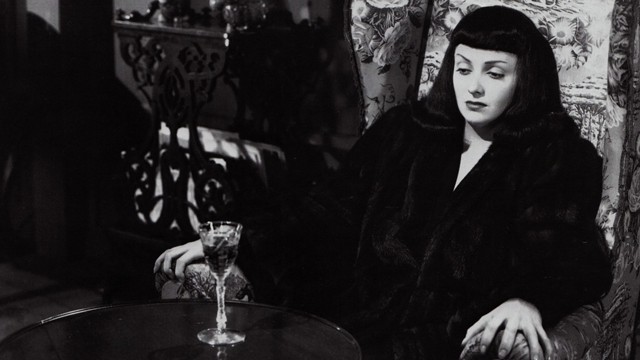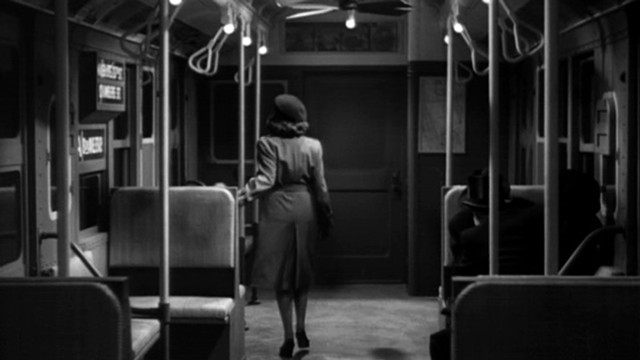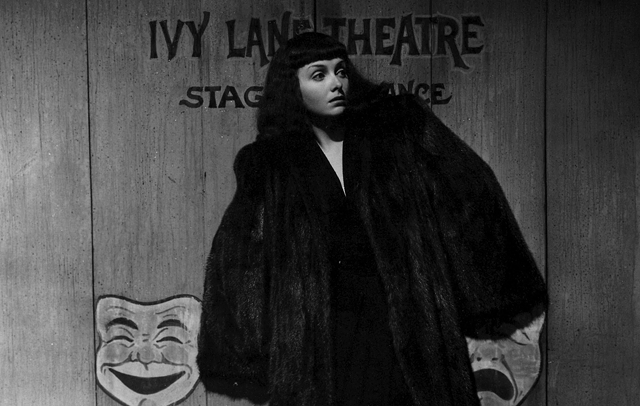
- RKO Radio Pictures
- Jean Brooks in The Seventh Victim
Mark Robson’s name is not particularly well remembered these days, though he directed many films whose titles retain some degree of cultural currency: The Bridges at Toko-Ri (1954), Peyton Place (1957), The Inn of the Sixth Happiness (1958), Valley of the Dolls (1967) and even his penultimate film, the cornball, all-star disaster movie Earthquake (1974).
These are the kinds of films that, while not necessarily beloved, show up as answers to questions on “Jeopardy!” But Alex Trebek would be highly unlikely to ask contestants to name their director, because Robson’s name just isn’t well known. (It could be a good “Final Jeopardy” stumper, in fact. Alex, you can send my royalty check courtesy of Seven Days.)
In the case of The Seventh Victim, Robson’s first directorial effort, whatever style he may possess is entirely swallowed up by the “house style” that producer Lewton forged as the supervisor of the horror unit at RKO. Best known for such stylish, atmospheric 1940s horror films as Cat People, The Ghost Ship and (my favorite; I have an original lobby card from it in my home office) I Walked with a Zombie, Lewton gained renown for doing a lot with a little. None of the 14 films he produced had a particularly large budget, but all of them are suave, gorgeous little movies. Rather than throw money at eye-catching effects or monsters, Lewton emphasized the clever and eerie use of lighting and cinematography to create mood and tension. The image below, from I Walked with a Zombie, is especially illustrative of this tendency.

- RKO Radio Pictures
- Expressive lighting in I Walked with a Zombie
The Seventh Victim is a curio of a film: a moody thriller that’s part mystery, part pre-Rosemary’s Baby investigation into New York City’s Satanic underground. At 70 minutes and without any major stars, The Seventh Victim is not quite an "A" picture and not quite a "B" picture — exactly the domain where Lewton (and his studio, RKO) operated in the early 1940s.
The film’s plot lurches awkwardly at times, and the performances of the two leading ladies, Jean Brooks and Kim Hunter, are less than dynamic. (I was most delighted to spy an uncredited Barbara Hale in a scene that takes place on the subway.) If the film is notable for anything, it’s for the stark, strange cinematography of the great Nicholas Musuraca, truly one of the greats and an artist whose work defined the semi-genre of film noir.

- RKO Radio Pictures
- The subway scene in The Seventh Victim
Even when Robson wasn’t overshadowed by a semi-legendary figure like Lewton, he never made much of a case for himself as a Major Artist. And that’s the weird — by which I mean “normal” — thing about Robson and directors like him. He had a three-and-a-half-decade career as a director in the biggest film industry in the world, and was nominated for major awards: a couple of Oscars and even Palme d’Or prizes at the Cannes Film Festival, which has always prided itself on being choosier and more artistically savvy than the Academy Awards.
Robson’s best-known films are known not for their artistic qualities, but for their embodying of a particular “moment” in American culture. Peyton Place, that notorious exposé of the seamy underbelly of 1950s suburbia, is probably the best example of this phenomenon, but even The Inn of the Sixth Happiness is better known for its (now-antiquated) take on matters cross-cultural than for its status as a work of art.
Even the Robson films that don’t “capture a moment” are better known for reasons unrelated to Robson. Von Ryan’s Express (1965) is that Frank Sinatra war film about POWs; Earthquake is one of the genre-defining disaster films; The Harder They Fall (1956) is Humphrey Bogart’s final film. Though nominally in charge of his films’ artistic vision, Robson was eternally overshadowed by his own work, for one reason or another.

- RKO Radio Pictures
- The Seventh Victim
Does The Seventh Victim give any clue about Mark Robson’s directorial style? Yes, inasmuch as his style is competent and unexceptional, without any strong signatures of its own. The lot of the run-of-the-mill Hollywood director is a curious one. They’re at their best when they’re at their most anonymous.
Speaking of...
-

A New Film Explores Vermont’s Unsung Modernist Buildings
Mar 20, 2024 -

A Film Critic Pays Final Respects to the Palace 9
Nov 11, 2023 -

Director Jay Craven Wins 10th Annual Herb Lockwood Prize
Oct 21, 2023 -

Book Review: 'Save Me a Seat! A Life With Movies,' Rick Winston
Aug 30, 2023 -

Steve MacQueen Named Executive Director of Vermont International Film Festival
May 22, 2023 - More »





Comments
Comments are closed.
From 2014-2020, Seven Days allowed readers to comment on all stories posted on our website. While we've appreciated the suggestions and insights, right now Seven Days is prioritizing our core mission — producing high-quality, responsible local journalism — over moderating online debates between readers.
To criticize, correct or praise our reporting, please send us a letter to the editor or send us a tip. We’ll check it out and report the results.
Online comments may return when we have better tech tools for managing them. Thanks for reading.